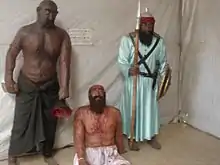Bhai Taru Singh
Bhai Taru Singh (c. 1720 – 1 July 1745)[1] was a prominent Sikh martyr known for sacrificing his life, in the name of protecting Sikh values, by having had his head scalped rather than cutting his hair and converting to Islam.[2][3]
Bhai Taru Singh | |
|---|---|
 Sculpture depicting Bhai Taru Singh being scalped by Mughal soldiers | |
| Born | 1720 Amritsar |
| Died | 1745 Lahore |
| Father | Bhai Jodh Singh |
| Mother | Bibi Dharam Kaur |
A 3D-animated film about Bhai Taru Singh was released globally on 27 April 2018.[4]
Biography
Bhai Taru Singh was born around 1720 into a Sandhu Jat family in Amritsar during the reign of the Mughal Empire. He was raised as a Sikh by his widowed mother and had one sister, Tar Kaur. Singh was engaged in agriculture at Poolha, Kasur, Lahore District,[5] where he had a small farm and grew maize.[6]
Upon witnessing Sikh fighters save a poor girl from the clutches of the Mughal oppressors, Bhai Taru Singh decided to become initiated into the Khalsa.[7] During this time, Sikh revolutionaries were plotting the overthrow of the Mughal governor of Punjab, Zakaria Khan. Singh and his sister gave food and other aid to the gursikhs (devout Sikhs of the Guru). An informant reported them to Zakaria Khan and the two were arrested for treason. Some sources, however, say that a mahant (akin to a 'great priest') was the one to have tipped off Mughal authorities because Bhai Taru Singh was harboring Sikh fighters.[5] Though his sister's freedom was bribed for by the villagers, Singh refused to seek a pardon.[8]
After a period of imprisonment and torture, Bhai Taru Singh was brought before the Khan and asked him where he got his powers from to undergo all of the agony. His reply was through his keshas ('unshorn hair') blessed by Guru Gobind Singh. Zakaria Khan then gave him the choice of either execution or conversion to Islam and having his hair cut off as an offering. Upon his refusal to forsake his religion, in a public display, Bhai Taru Singh's scalp was cut away from his skull with a sharp knife to prevent his hair from ever growing back. According to prominent early Sikh historian Ratan Singh Bhangu, in response to having his scalp torn off, Taru Singh cursed Zakaria Khan, saying he would be killed by his shoes.[9] According to Sikh sources, after cutting Singh's scalp, Zakaria Khan was stricken with unbearable pain and the inability to urinate. As a last resort, Khan sent an apology to the Khalsa Panth for his persecution of Sikhs and begged for forgiveness. It was suggested that if Khan hit himself with Singh's shoes, his condition might be lifted. Although it would cure Khan of his condition, he died 22 days later from having hit himself with the shoes, just as Singh predicted. Upon hearing that he had outlived the Khan, Bhai Taru Singh died on 1 July 1745.[10]
Legacy
In AD 1762, the Bhangi Sikh Sardar army conquered Lahore and took over the public square where Singh was scalped. The Abdullah Khan Mosque adjacent to the square was also occupied and converted into Shaheed Ganj Gurdwara.[11] On the location today, Gurudwara Shaheed Bhai Taru Singh in Naulakha Bazaar, marks the place where Singh's scalp and hair was removed.[10]
Pop culture
- A print representing Singh's martyrdom is present in the 2007 film The Darjeeling Limited, in a scene set in a Sikh temple.[12]
- A 3D-animated film about Bhai Taru Singh was released globally on 27 April 2018, directed by Vismaad Singh.[4][13]
References
- "Sikh Martyrs – Bhai Taru Singh". Search Sikhism.
- Fowler, Marsha; Kirkham, Sheryl; Sawatzky, Rick; Taylor, Elizabeth (2011). Religion, Religious Ethics and Nursing. New: Springer Publishing Company. p. 261. ISBN 9780826106643.
- French, Louis (2000). Martyrdom in the Sikh Tradition: Playing the "Game of Love". Oxford University Press. p. 146. ISBN 9780195649475.
- Bhai Taru Singh at IMDb
- Singh, H.S. (2005). The Encyclopedia of Sikhism (Second ed.). New Delhi: Hemkunt Press. p. 195. ISBN 9788170103011.
- Singh, Ranbir (1968). The Sikh way of Life. India Publishers. p. 136.
- French, Louis; Singh, Pashaura (2006). Dealing with Deities: The Ritual Vow in South Asia. New York: SUNY Press. p. 210. ISBN 9780791467084.
- "Martyr:Bhai Taru Singh". Sikh Link. Archived from the original on 1 December 2008. Retrieved 12 November 2016.
- French, Louis (2000). Martyrdom in the Sikh Tradition: Playing the "Game of Love". Oxford University Press. p. 220. ISBN 9780195649475.
- Iqbal Qaiser. "Gurudwara Shaheed Ganj Bhai Taru Singh". All About Sikhs. Archived from the original on 5 November 2006.
- Masjid Shahid Ganj Mosque vs Shiromani Gurdwara Parbandhak ... on 2 May 1940
- https://www.youtube.com/watch?v=Xc0rHJ3zY7A
- "Vismaad Unveils Poster & Teaser of 3D Animation Film "Bhai Taru Singh"". www.ghaintpunjab.com. Retrieved 23 February 2018.